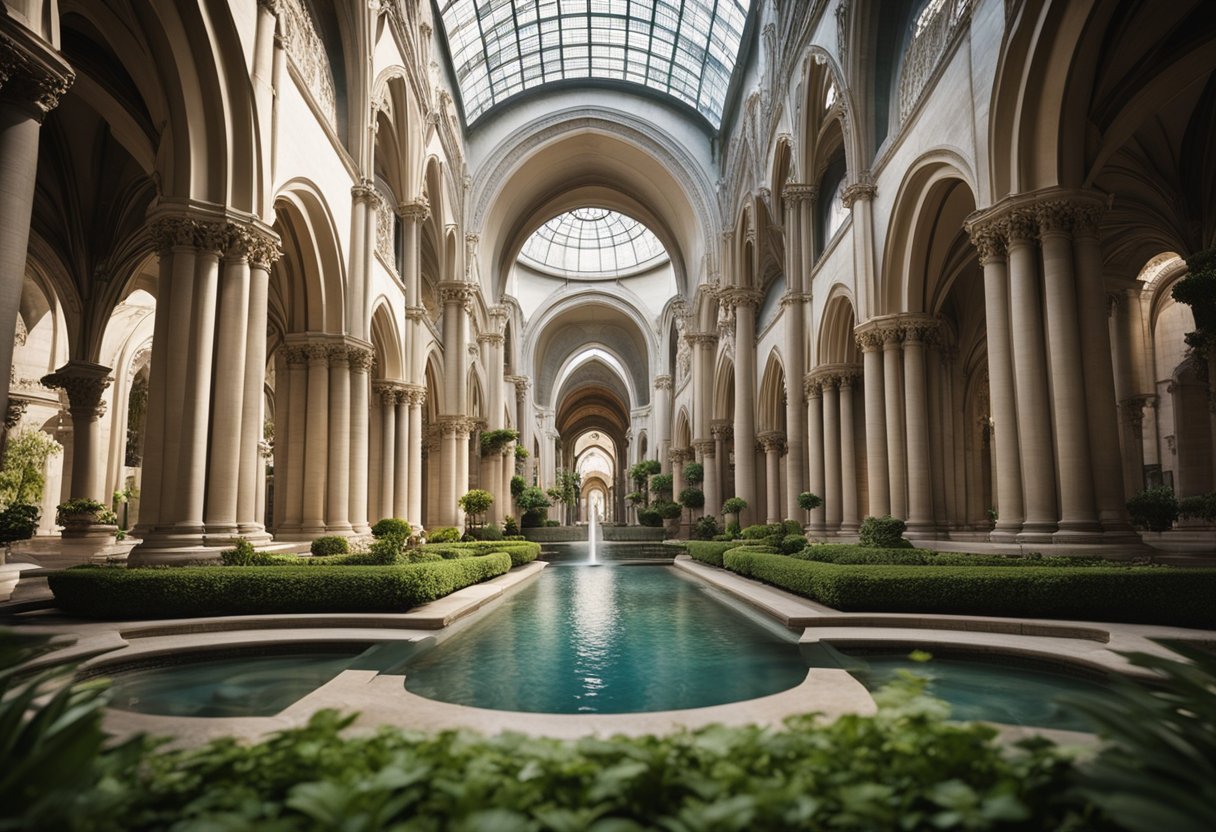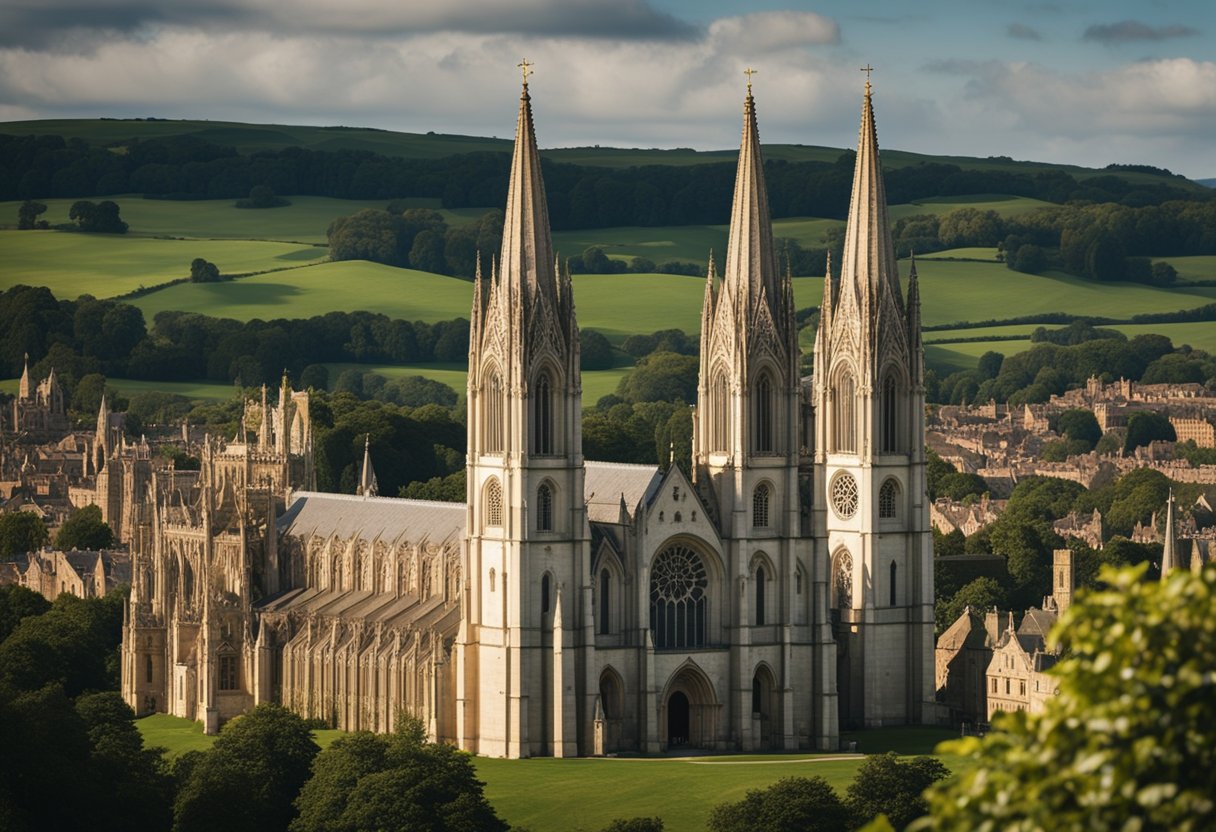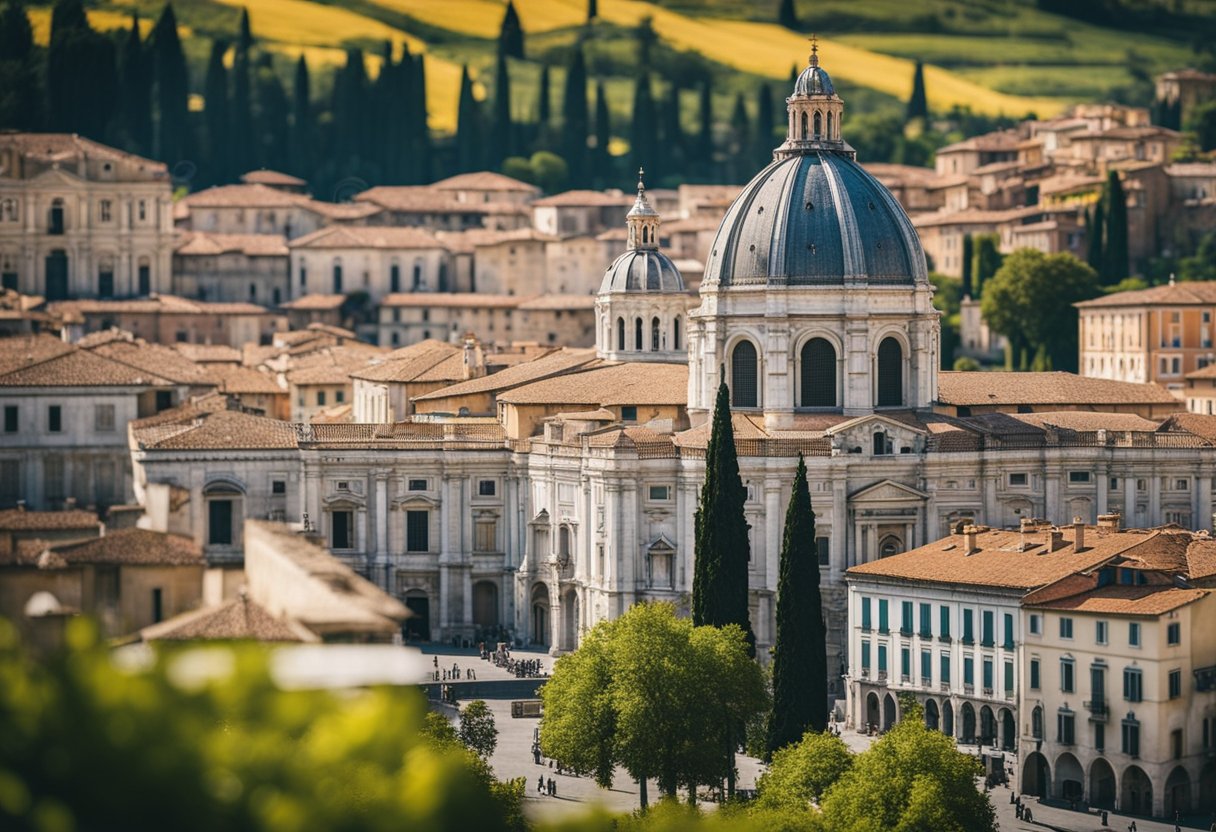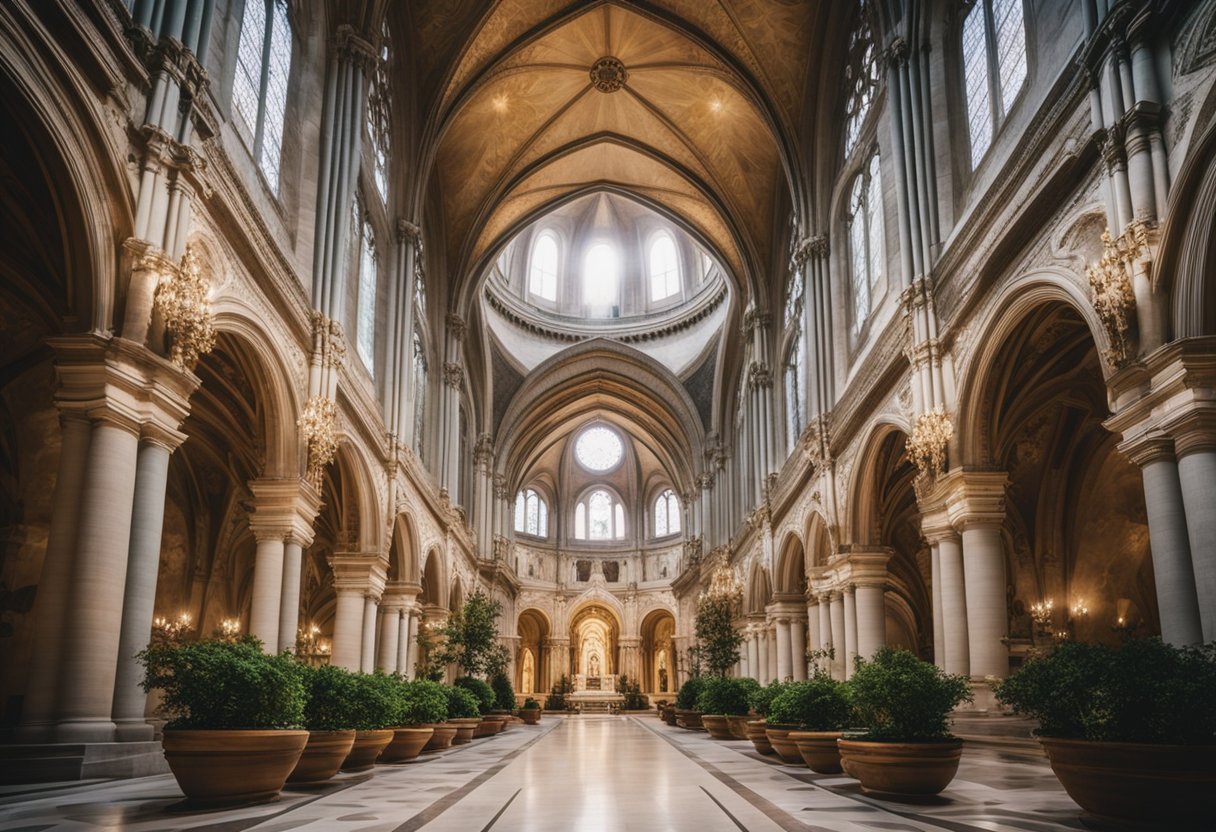The Renaissance Influence: Tracing Art and Architecture From Italy to the British Isles

Updated On: April 16, 2024 by Raghda Elsabbagh
The Renaissance was a profound epoch that reshaped the cultural and architectural landscapes of Europe, beginning in Italy before weaving its influence throughout the British Isles. This period saw the rebirth of classical antiquity’s principles, echoing the grandeur of Roman and Greek civilisations. As a wave of artistic and architectural revolution, the Renaissance left an indelible mark, breathing new life into the realms of visual arts and urban design. Wealthy patrons and intellectual movements, like Humanism, spurred this revival of classical learning and aesthetics, which gradually diffused across Europe.

Italy served as the cradle of Renaissance creativity, producing luminary artists and architects whose works are celebrated for their innovation and beauty. Historical townscapes across the British Isles still bear the hallmarks of this revolutionary period, displaying the reach of Renaissance architecture and artistic philosophy. It was the architects and thinkers influenced by their Italian counterparts who tailored the Renaissance ideals into a unique vernacular dialogue, which resonated deeply within British cultural developments.
Table of Contents
Origins and Early Renaissance in Italy
As we explore the Renaissance, it’s crucial to understand its roots in Italy, a period marked by a significant transition in art and culture.
Transition from the Middle Ages
The Early Renaissance in Italy signalled a metamorphosis from the Gothic style that had dominated the Middle Ages. Gothic architecture, noted for its pointed arches and elaborate ornamentation, began to give way to a style inspired by the Classical heritage of Rome and Greece. The architectural forms became more symmetrical and harmonious. Florence was the epicentre of this cultural rebirth, with artists and architects drawing inspiration from the ruins of Ancient Rome that surrounded them.
Humanism and Its Impact on Arts
Humanism in the Renaissance represented a revitalising current, a profound shift in thinking that placed emphasis on the importance of the individual and the study of classical antiquity. In arts, this led to an increased realism in painting and sculpture, seeking to capture the world and the human form as accurately and as beautifully as possible. The Early Renaissance, in the wake of Humanism, produced works that were less rigidly religious and more explorative of human experience and the natural world.
Renaissance Art and Artists
In this exploration of Renaissance art, we focus on the revival and evolution that defined the era, spotlighting iconic figures like Michelangelo and Leonardo da Vinci. We delve into the significance of painting and sculpture, recognising their tribute to classicism and realism.
The Flourishing of Renaissance Painting
Renaissance painting marked a pivotal departure from the flat figures and symbolic representations of earlier periods. Key pioneer Masaccio introduced a persuasive realism to his frescoes, employing techniques like linear perspective that added depth to the painted world. Figures in works by Leonardo da Vinci and Raphael displayed an enhanced understanding of anatomy and emotion, capturing the human experience with nuanced expression. Sandro Botticelli’s pieces often featured allegorical subjects, mastering the use of symmetry to draw the viewer’s eye.
Sculpture: Reclaiming Classicism
Sculpture during the Renaissance saw a return to the harmonious proportions and naturalism of ancient Greco-Roman art. Donatello pioneered this revival; his statues imbued with a sense of individuality and psychological depth previously unseen. Michelangelo’s sculptures, meanwhile, epitomised the High Renaissance’s ideals through their powerful portrayal of the human form and emotive force. His mastery of both marble and bronze set a standard for future generations, as he carved out figures so lifelike they seemed poised to escape their stone confines.
Architectural Innovations and Masterpieces
Renaissance architecture marked a profound shift in design, embracing symmetry, proportion, and the classical orders. This era produced remarkable buildings and structures that remain iconic to this day.
Domes: Filippo Brunelleschi and Beyond
Filippo Brunelleschi stands as a pivotal figure in architectural history, pioneering the use of the dome with his crowning achievement, the Santa Maria del Fiore in Florence. His innovative approach involved the use of a double shell with a distinctive octagonal shape. Brunelleschi’s dome, completed in 1436, remains an enduring symbol of Renaissance architecture.
The techniques and principles established by Brunelleschi influenced countless other structures. For instance, The Tempietto in Rome, designed by Donato Bramante, showcases the enduring legacy of this shift in architectural design, featuring a central plan and a dome that echoed the classical past.
Renaissance Architects and Their Legacies
Our journey through this transformative era brings us to Leon Battista Alberti, who applied mathematical harmony and classical ideals to his works. The Palazzo Rucellai is an exquisite example, displaying Alberti’s incorporation of Pilasters and the Classical Orders—a façade that brought ancient Rome to the streets of Florence.
Renaissance architects were also renowned for the Palladian window, an architectural motif named after Andrea Palladio, whose work was inspired by the symmetry and values of classical temples. This feature became fundamental to Palladianism and can be observed in structures throughout the British Isles, such as the Queen’s House in Greenwich.
Institutions like the Ospedale degli Innocenti illustrate the use of rhythmic spaces, arches, columns, and proportional systems that have defined the symmetrical nature of Renaissance architecture. These masterpieces and the principles they followed laid the groundwork for the spread of Renaissance ideas far beyond Italy’s borders.
Renaissance Humanism and Philosophical Thought
Renaissance Humanism marked a significant shift in philosophical thought, characterised by a renewed enthusiasm for Classical texts and a focus on human potential and achievements.
Humanist Philosophy and Renaissance Cultures
Humanist thinkers spearheaded a cultural revival that changed the landscape of Europe, starting in Italy. At its heart, this movement placed human potential and experience at the centre of scholarly pursuits. Petrarch, known as the ‘Father of Humanism’, championed the study of Latin literature, sparking a flame that would ignite intellectual passion across the continent. Texts from antiquity were not only rediscovered but revered, leading to a Classical revival that affected various aspects of society, including art, science, and politics.
Our understanding of humanist philosophy sees it as a springboard for cultural development. With its emphasis on individual dignity and worth, humanism helped to juxtapose the secular with the divine, altering societal values and norms. Collegiate curricula were reshaped to embrace humanist principles, with educational institutions embedding Classical studies into their programmes, thereby equipping future generations with a lens through which to assess and shape the world.
Influence on Education and Society
Humanism’s impact on education was profound, with the establishment of schools and universities that favoured humanist curricula, keen on fostering philosophical, literary, and historical understanding among scholars. Latin remained the lingua franca of educated Europeans, nurturing a transnational intellectual community.
In the wider society, humanism engendered an environment where critical thought and empirical observation flourished. This set the scene for nuanced discussions on governance and the role of the individual within the state. It marked a departure from medieval scholasticism and paved the way for modern scientific and political theories.
By instilling a sense of human-centred inquiry, humanist principles cultivated a fertile ground upon which the Renaissance could bloom not only in Italy but across the British Isles and throughout Europe. Our appreciation for this transformative era recognises the deep roots humanism has in shaping contemporary Western thought.
The Role of the Medici Family in the Renaissance
As we explore the intricate web of influence that shaped the Renaissance, we must acknowledge the pivotal role of the Medici family. Their financial and cultural patronage was instrumental in catalysing the flourishing of arts and ideas in Florence, which rippled throughout society.
Patrons of Art and Architecture
The Medici’s patronage of the arts was unparalleled; it manifested in the commissioning of artworks and the construction of architectural marvels. Cosimo de Medici, the family patriarch, invested in the creation of numerous buildings that exemplified Renaissance architecture and humanism. His support for early Renaissance art was decisive in establishing Florence as a cultural hub. Under Medici’s patronage, artists like Sandro Botticelli and Leonardo da Vinci created works that have captivated generations.
The Medici as Drivers of Cultural Change
Beyond art, the Medici’s influence extended deeply into the cultural and intellectual life of Florence. Through their support of scholars, poets, and humanists, the family fostered an environment ripe for innovation and change. The family’s most famous figure, Lorenzo de Medici, known as “Lorenzo the Magnificent,” was himself a poet and a connoisseur of the arts. The Medici also contributed to the political sphere, often aligning with the popular party in Florence and asserting their presence in European politics. Their patronage and political involvement not only transformed Florence but also set precedents that influenced the rest of society during and beyond the Renaissance period.
Spread of Renaissance Ideas Across Europe

As we trace the influence of the Renaissance from Italy to the British Isles, it’s clear that this cultural rebirth was marked by the flourishing of the arts and a renewed interest in the classical antiquity of Greece and Rome. Renaissance ideas were carried across Europe through increased trade, the movement of artists and scholars, and the advent of the printing press, leading to a transformation of urban landscapes with new architectural concepts.
The Transmission to France
France became an early adopter of Renaissance art and architecture, particularly during the reign of Francis I, who was an enthusiastic patron of the arts. He invited renowned Italian artists like Leonardo da Vinci to his court, which resulted in a significant diffusion of Renaissance styles. The iconic Château de Chambord stands as a testament to the melding of French Gothic structures with classical Italian Renaissance design, characterised by its symmetrical layout and ornate façades.
Renaissance Influence in England
In England, the spread of Renaissance ideas was more gradual, manifesting notably in the Henrician and Elizabethan periods. The influence was more pronounced in cultural aspects such as literature and drama, with the works of William Shakespeare being a prime example. However, Renaissance architecture slowly began altering the English urban landscape, with the Old Royal Naval College in Greenwich showcasing the classical columns and domes indicative of this era. During our time, we have seen how such landmarks continue to be celebrated and preserved.
The High Renaissance and Mannerism
As we explore the impactful period of the High Renaissance and its eventual segue into Mannerism, we’ll focus on the influential masters and stylistic shifts that defined these eras.
Defining the High Renaissance
The High Renaissance, a term closely associated with Italy from around 1490 to 1520, represents the zenith of Renaissance art, characterised by harmony, balance, and a pursuit of ideal beauty. This period is defined by the genius of three towering figures of art history: Michelangelo, Leonardo da Vinci, and Raphael. Their works epitomised the High Renaissance’s ideals, with Michelangelo’s breathtaking Sistine Chapel ceiling, Leonardo’s enigmatic ‘Mona Lisa‘, and Raphael’s grand compositions in the Vatican Rooms serving as exemplars of this epoch.
Mannerism: The Stylistic Evolution
In the wake of the High Renaissance, Mannerism emerged as a distinct style that flourished from the 1520s to the 1590s. It is recognised by its artificiality, elongated proportions, and tension-ridden compositions as opposed to the harmonious and proportionate works of the High Renaissance. Mannerism reflected a change in the cultural and artistic paradigm, with artists like Pontormo breaking away from naturalism towards more expressive and emotionally charged art. This evolution marked a significant shift from the emphasis on perfection to a more subjective interpretation of human experience and artistic expression.
Renaissance Thinkers and Their Legacy
The Renaissance was a time of extraordinary intellectual growth and output that laid the foundations for modern Western culture. Renowned thinkers in the fields of science, mathematics, literature, and philosophy challenged existing dogmas and placed humans at the centre of the universe, giving rise to Humanism.
Science, Mathematics, and Exploration
Vitruvius, an ancient Roman architect, wrote “De Architectura,” which profoundly informed Renaissance thinking. He emphasised the importance of symmetry and proportion, which became guiding principles for Renaissance art and architecture. Petrarch, deemed the “Father of Humanism,” re-emphasised classical Greek and Roman teachings, thus shaping the intellectual currents of the time. The era’s achievements in mathematics were significant, with advances that underpinned explorations and scientific discoveries. Mathematics became the framework upon which exploration and the understanding of the cosmos expanded, as European explorers charted previously unknown lands.
Literature and Poetry of the Renaissance
Renaissance literature embodied the concepts of Humanism in texts that explored individual humanity and the broader human condition. Well-crafted words were considered a reflection of an ordered, rational mind and an ordered universe. Petrarch’s poetry, particularly the “Canzoniere,” was instrumental in developing the sonnet form and influencing European poetry. It is in this artistry we find the enduring legacy of Renaissance thinkers, a legacy inseparable from the cultural tapestry that shaped Europe and reached as far as the British Isles.
Renaissance Techniques: Linear Perspective and Beyond
In the Renaissance period, breakthroughs in artistic techniques, particularly linear perspective, marked a new era in art and architecture, fostering clarity and realism in works that continue to influence design to this day.
The Discovery of Perspective in Art
During the early 15th century, the concept of linear perspective revolutionised visual art, thanks to the pioneering work of Filippo Brunelleschi. This method provided artists with a mathematical framework to recreate three-dimensional space on a two-dimensional surface. By establishing a vanishing point to which all parallel lines on the plane of the painting or drawing would converge, artists achieved an illusion of depth unmatched by previous methods. Our understanding of these techniques has been enriched by in-depth studies like those found in articles about the Early Applications of Linear Perspective by Brunelleschi.
The incorporation of linear perspective reflected the Renaissance era’s humanist belief, merging artistic endeavour with scientific inquiry and mathematics. As a result, artworks from this time exhibit an unprecedented level of visual accuracy and detail, characteristics we regard as fundamental for the realism that defined Renaissance art.
Technical Mastery in Renaissance Works
Renaissance artists and architects, building on the foundation of linear perspective, achieved technical mastery that demonstrated their deep understanding of the natural world and the human form. Figures were not only placed within a convincing three-dimensional setting but also rendered with volumetric precision and anatomical correctness. Painters such as Masaccio and Leonardo da Vinci meticulously applied these principles, and we can observe the effectiveness of their techniques in artworks where Linear Perspective in Renaissance Art played a crucial role in conveying spatial depth.
Furthermore, clarity and order became guiding principles in architecture, with structures designed to embody the proportionality and symmetry that mathematics could offer. For example, the buildings of Andrea Palladio exemplify the application of geometrical harmony, embodying the humanist ideals of balance and proportion that were central during the Renaissance.
By embracing linear perspective and the associated technical advancements, Renaissance artists and architects have left us a legacy through which we can trace the evolution of modern visual culture and built environments, from the great cities of Italy to the architectural heritage of the British Isles.
Post-Renaissance Developments

Following the Renaissance, artistic and architectural styles continued to evolve across Europe, yet their roots remained firmly planted in Renaissance principles. Let’s explore two significant facets that define this period of progression.
Baroque: The Next Artistic Chapter
In the 17th century, Europe witnessed the rise of the Baroque style, characterised by its dramatic use of light, lush details, and an overall sense of movement and grandeur. Baroque emerged as an extension of the artistic ideals of the Renaissance, yet it communicated a more emotional experience. In Italy, architects like Gian Lorenzo Bernini pushed the boundaries of design with their sweeping curves and decorated surfaces in structures such as St. Peter’s Basilica.
We find that Baroque elements traversed across nations, with each incorporating its local cultural nuances. For instance, in the British Isles, Baroque found expression in buildings like St. Paul’s Cathedral, where Sir Christopher Wren infused Renaissance influence with the grandiosity of Baroque, echoing Europe’s artistic dialogues.
The Enduring Influence of Renaissance Thought
While the visual arts transitioned to Baroque opulence, the philosophical underpinnings of the Renaissance persisted. European thought continued to be shaped by the humanistic philosophy that positioned humans at the centre of the intellectual and moral universe.
In the realm of philosophy, descendants of Renaissance humanism initiated discussions that would direct modern philosophy. This is evident in how the British Isles embraced concepts like empiricism, which can be traced back to the value the Renaissance placed on observational knowledge. Our understanding of European philosophy’s debt to Renaissance influence is crucial to grasp the full scope of its impact.
Frequently Asked Questions

In this section, we address common inquiries about the influence of the Renaissance on architecture from Italy to the British Isles, providing insights into its defining traits, exemplars, and the continuation of its principles in modern construction.
What are the defining characteristics of Renaissance architecture?
Its symmetry, proportion, and geometry distinguish Renaissance architecture and the regularity of parts, as demonstrated in the architecture of antiquity, especially in the temples of ancient Greece and Rome. ArchDaily elaborates on how this era marked a departure from the more complex Gothic style, favouring clarity and classical simplicity.
What are some notable examples of Italian Renaissance architectural works?
Notable examples include Florence’s Cathedral, with its dome designed by Filippo Brunelleschi, the Basilica of San Lorenzo, and the Palazzo Rucellai, which showcase the quintessence of Italian Renaissance art.
In what ways did French Renaissance architecture diverge from its Italian predecessor?
French Renaissance architecture began to infuse Italianate elements with local French styles, leading to elaborate decorations and a distinct flamboyance. While French designers borrowed elements like columns and pilasters, they incorporated them into structures that retained a Gothic influence, particularly in their ornate châteaux.
Can you identify modern buildings that are influenced by Renaissance architectural principles?
Certainly, modern buildings continue to draw upon Renaissance architectural principles. The United States Capitol building and Thomas Jefferson’s Monticello estate are prime examples of modern structures that blend classical elements common to Renaissance aesthetics with contemporary design.
Who were the key figures responsible for introducing Renaissance architecture to the British Isles?
In the British Isles, Inigo Jones is considered one of the pioneers in introducing Renaissance architecture in the 17th century. Influenced by his travels in Italy and the works of Palladio, Jones’s designs, such as the Queen’s House in Greenwich, set the precedent for classical design in Britain.
What influence did the Italian Renaissance have on British art and architectural styles?
The Italian Renaissance had a profound impact on British art and architectural styles. It encouraged a shift towards classical antiquity in British culture, with architects incorporating symmetry, perspective, and proportions derived from their Italian counterparts. This is evident in structures such as St. Paul’s Cathedral, where Sir Christopher Wren infused Renaissance ideals with a Baroque flair.






